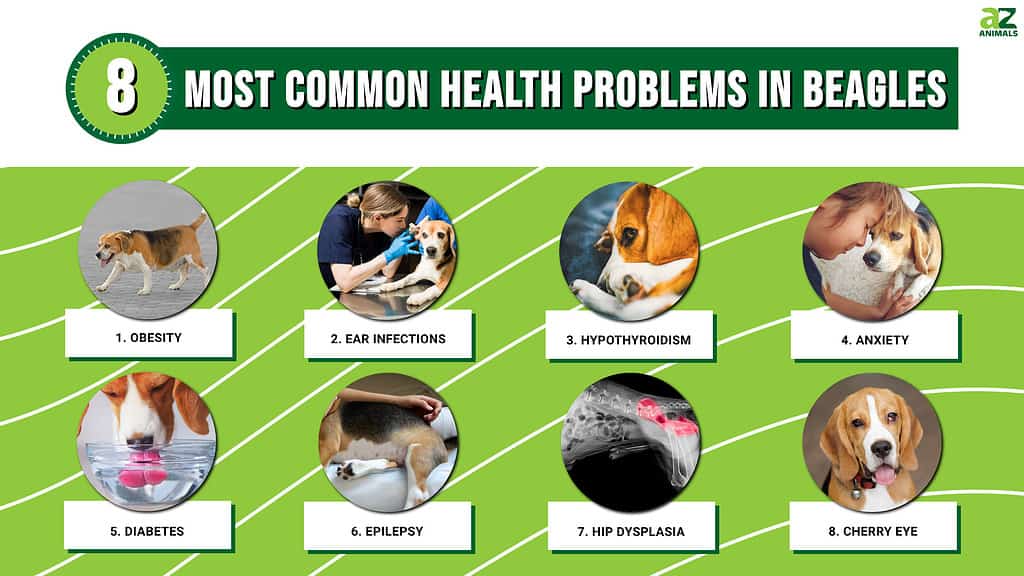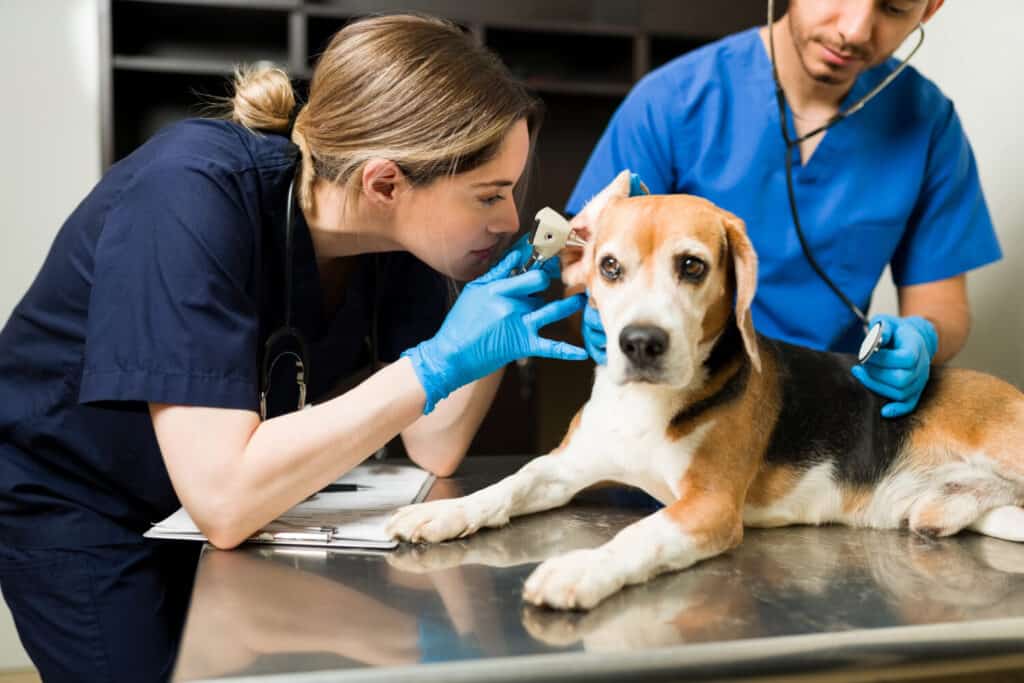Pet parents should be familiar with their dog’s breed, including the most common health problems, for a multitude of reasons. For one, your fur family members can’t tell you what’s wrong and where they feel discomfort. But if you are aware of common ailments that certain breeds are prone to, you can be better prepared and know the signs to look out for. Get familiar with the eight most common health problems in beagles, including signs, symptoms, and treatments.

Do Beagles Have a Lot of Health Issues? What is Their Lifespan?
On average, beagles live 12 to 15 years, but many surpass these numbers with proper care. This breed is relatively hardy and long living due to its smaller size. Indeed, smaller dogs live longer than larger dogs. But beagles are still prone to several health problems that tend to plague purebreds, as well as susceptible to viral infections that can affect any breed.
Let’s break down some of the most common health problems in beagles.
1. Obesity

Obesity is one of the most common health problems in beagles.
©tsik/Shutterstock.com
Beagles are among the breeds most at risk for being obese, about two times more likely than other dogs. This breed’s normal weight range is between 19 and 24 pounds, and those on the shorter side (13 inches or less) should weigh under 20 pounds.
If you know anything about beagles, you know they love food. They will scarf down whatever is in front of them without a second thought. While their mighty appetites are part of what makes this breed so lovable, it’s also the main reason beagles easily gain too much weight. Obesity in dogs can lead to arthritis, diabetes, respiratory issues, heart disease, and ligament and tendon problems.
To keep your beagle in tip-top shape, ensure they eat a healthy diet and watch portions. They should also get at least an hour of exercise each day, whether walking, running, or intense playing.
2. Ear Infections

Beagles are prone to ear infections due to their long, floppy ears covering the ear canal and reducing air.
©Beach Creatives/Shutterstock.com
Your beagle’s long, floppy ears give it a forever puppy look. And while they are adorable, this breed’s ears have reduced airflow in the ear canal, possibly leading to chronic ear infections. The best way to prevent ear infections in beagles is to regularly check the canal for scratches, dirt, parasites, strong odors, discharge, or anything else concerning. And be sure to thoroughly clean your beagle’s ears once a month, maybe more if they have recurring issues.
3. Hypothyroidism

Is your beagle lethargic and gaining weight without overeating? It could be hypothyroidism
©Przemek Iciak/Shutterstock.com
If your beagle is gaining weight but isn’t overeating, hypothyroidism may be to blame. Other signs of this disease include lethargy, cold intolerance, dry hair, excessive shedding, and dark pigmentation on the skin. This genetic disease affects the thyroid glands, causing insufficient blood levels of the thyroid hormone. If diagnosed, your dog will most likely need medication for life. But thankfully, it can lead a normal, healthy life.
4. Anxiety

Anxiety is common in beagles because of their social personalities.
©Nina Buday/Shutterstock.com
Beagles can be jumpy, fearful, and anxious dogs. If you notice your fur friend pacing, drooling, being destructive, or biting when you’re away, there’s a good chance they have anxiety. This breed is highly sociable and needs to be around people and other pets. Beagles were originally bred to live in large packs, so they don’t do well on their own. Exercise, mental stimulation, and socialization can help ease anxiety in dogs. There is also an FDA-approved treatment for separation anxiety.
5. Diabetes

Excessive thirst and increased urination is a sign of diabetes in dogs
©ALEX_UGALEK/Shutterstock.com
If you notice a ravenous appetite combined with increased thirst, more frequent urination, and weight loss, you should schedule an appointment for your beagle with the vet. These symptoms can point to diabetes, which is common among purebred beagles. While getting a diabetes diagnosis can be scary, your beagle can go on to live a full life with the proper treatment and care.
6. Epilepsy

Seizures in beagles can begin as early as six months old.
©iStock.com/Aleksandr Zyablitskiy
Epilepsy is an inherited condition in beagles, with most exhibiting seizures within the first six months to three years of life. Signs of epilepsy in dogs include convulsions, twitching, strange/repetitive movements, or moaning/howling. It can be shocking to see your beloved pup have seizures. But anti-convulsant medication can result in a relatively normal life, with most dogs reaching their average lifespans.
7. Hip Dysplasia

Hip dysplasia can be painful but it’s treatable.
©Intarapong/Shutterstock.com
This condition is rather common in many breeds, including beagles. It is a degenerative condition that impairs mobility, gait, and behavior. It can also be painful and cause depression and mood changes. Be sure to have your dog evaluated if you notice limping or a reluctance to be active and climb stairs. There are hip dysplasia surgeries that can correct this issue in beagles, allowing them to go on and live normal lives.
8. Cherry Eye

Cherry eye is a common health problem in beagle.
©Warut Chinsai/Shutterstock.com
Have you noticed a red mass in the corner of your beagle’s eye? This could be a cherry eye. Cherry eye occurs when a dog’s third eyelid prolapses, and it is pretty common in this breed. Thankfully, it is not life-threatening and can be easily treated with eye drops, medications, and possibly surgery.
Most Common Problems in Beagles: A Recap of the Top 8
| Number | Most Common Problems in Beagles |
|---|---|
| #1 | Obesity |
| #2 | Ear infections |
| #3 | Hypothyroidism |
| #4 | Anxiety |
| #5 | Diabetes |
| #6 | Epilepsy |
| #7 | Hip dysplasia |
| #8 | Cherry eye |
The photo featured at the top of this post is © Warut Chinsai/Shutterstock.com
Ready to discover the top 10 cutest dog breeds in the entire world?
How about the fastest dogs, the largest dogs and those that are -- quite frankly -- just the kindest dogs on the planet? Each day, AZ Animals sends out lists just like this to our thousands of email subscribers. And the best part? It's FREE. Join today by entering your email below.
Thank you for reading! Have some feedback for us? Contact the AZ Animals editorial team.







